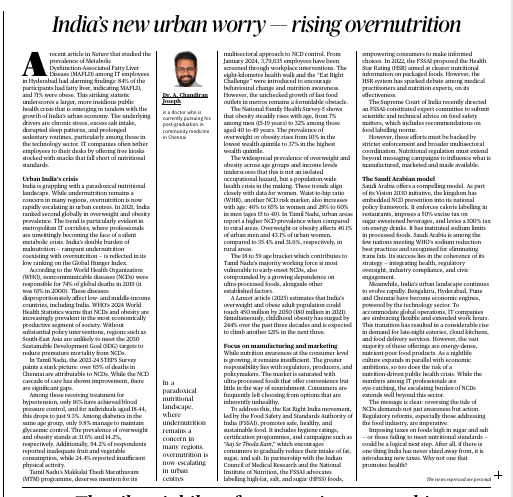🟠 Context and Premise
- A recent article in Nature highlighted how overnutrition is surpassing undernutrition as the leading cause of malnutrition in Indian urban areas.
- Indian cities like Hyderabad are witnessing increased consumption of ultra-processed foods (UPFs), contributing to rising cases of non-communicable diseases (NCDs) like obesity, diabetes, hypertension, etc.
🟠 Urban India’s Nutrition Crisis
- Dual burden of malnutrition: Co-existence of undernutrition and overnutrition.
- Overnutrition Trends:
- More prevalent in urban populations.
- Triggered by higher incomes, sedentary lifestyles, and easy access to UPFs.
- Influenced by aggressive marketing, advertising, and misleading food labels.
- More prevalent in urban populations.
- NCD Risks:
- Affects productivity and healthcare systems.
- Creates a socio-economic burden on the nation.
- Affects productivity and healthcare systems.
🟠 Current Policy and Program Landscape
- National efforts so far:
- National Health Policy 2017.
- Eat Right Movement by FSSAI.
- National Multisectoral Action Plan (NMAP) for NCDs.
- National Health Policy 2017.
- Shortcomings:
- Fragmented approaches with poor inter-sectoral coordination.
- Lack of focus on preventive nutrition.
- Absence of front-of-pack labelling and clear consumer education on unhealthy food ingredients.
- Fragmented approaches with poor inter-sectoral coordination.
🟠 Global Lessons: Saudi Arabia Model
- Saudi Arabia imposed a tax on sugar-sweetened beverages (SSBs).
- Introduced front-of-pack nutrition labels and limited marketing of junk food.
- Resulted in:
- Decline in SSB consumption.
- Increased public awareness.
- Successful intersectoral action involving health, education, finance, and media sectors.
- Decline in SSB consumption.
🟠 Recommendations for India
- Strengthen intersectoral coordination under NMAP.
- Implement mandatory front-of-pack labelling on processed foods.
- Control junk food marketing, especially targeting children.
- Impose fiscal policies (like sugar taxes) on UPFs and SSBs.
- Encourage urban food environments to promote healthy choices.
- Increase investment in public awareness and school-based nutrition education.
🟠 Conclusion
- India must shift focus from only addressing undernutrition to also tackling overnutrition, especially in cities.
- A holistic, rights-based, and evidence-based approach is needed to safeguard urban public health from the rising burden of lifestyle-related diseases.
Practice question:
Q. Rising overnutrition in Indian urban areas presents a new public health challenge. Discuss its implications and suggest policy interventions to address this dual burden of malnutrition.
(10 marks, 150 words)


